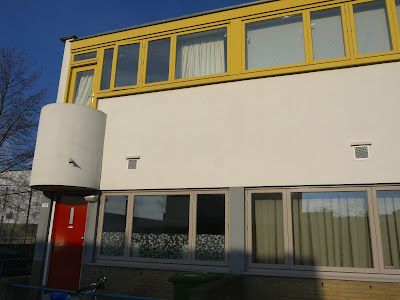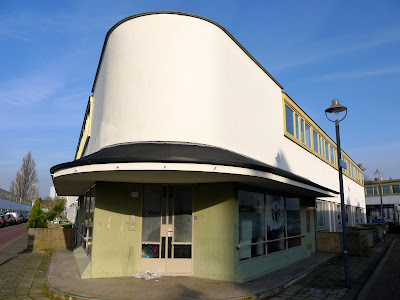There are several examples of social housing estates in Europe, constructed in the 1930's and designed to improve the living conditions of working class people. Rotterdam has one of the most famous examples of this development - the Kiefhoek Estate, originally constructed between 1925 and 1930 and designed by the iconic Dutch architect J.J.P.Oud.
The Kiefhoek included 300 dwellings, a church, two shops, a hot water service and outside playground spaces to provide facilities for the many children that lived in the original development. The estate's plan is based on rows of standardised two storey homes with up to three bedrooms. Oud took an extremely functional approach to designing the dwellings, all of which have white rendered facades but adding a splash of colour with the red doors, yellow window frames and blue gates that are a clear reference to the De Stijl school of design. The only other external decoration occurs on homes at the end of streets where a small rounded balcony is positioned above the front door.
The buildings that visitors see today are not the original structures. Over the years the buildings deteriorated, primarily due to the lack of robust foundations and between 1989 and 1995, the estate was demolished and rebuilt. The smaller dwellings were combined to adapt them to modern day living and to make more space available. Architect Wytze Patijn was responsible for the re-design which maintains the original exterior features, including the iconic and much photographed curved shop units at the end of the Kiefhoek's longest streets. The units are no longer used as shops, serving instead as spaces for community activity. They would make great gallery spaces. Today's residents have access to a large selection of shops a short walk away on the main road.
It is still possible to see how the estate's earlier residents lived as one of the buildings has been reconstructed as a single unit, true to the original design and to act as a museum. The tiny two storey dwellings, less than four metres wide accommodated a living room, small kitchen, toilet and up to three bedrooms. Dutch working class families could be large and many of the units would have been home to families with up to six children sleeping in bunk beds, some with three levels! The tiny ground floor lounge included a storage cupboard for food and crockery and it is difficult to see how the larger families could have comfortably sat down together. However, there is no doubt that the Kiefhoek offered far superior housing to that lived in by most Dutch working families during this period, with separate kitchen space including a shallow ceramic sink which would be deemed fashionable today and even some outside space at the rear where vegetables could be grown to help make the family income go further.
The upper floor was reached by a spiral staircase. In the museum, the steps and the bannister are painted yellow, again referencing De Stijl, and the colour is set off by the natural light that floods in via the windows at the top of the stairs. This natural light is supplemented by a sliding frosted glass window that separates the stairwell from the third bedroom - an ingenious touch demonstrating the thought that went into the design process. Oud's original proposals also included a shower under the stairs, a folding ironing board and an extra sink in the hall, but these were rejected.
As well as the two shops and playgrounds, the estate had its own church. Also designed by Oud, it is a modernist box with the same white rendered facade as the homes but with some additional decorative features, including the beautiful stained glass windows and the stylised lettering on the front which includes its date of construction - 1929. The stained glass designs are echoed in the windows of one of the houses opposite - a window that also has two very alive and large parrots on display!
The estate can be visited at any time but to see inside the museum, its necessary to make an appointment and take a guided tour from Rotterdam's UrbanGuides who can also make arrangements for tours of other architectural landmarks in the city.
You might also like Dutch Modernism 1 - Rotterdam's Cafe de Unie , another of J.J.P. Oud's works, Modernism and Elegant Swimming Pool and Red Vienna which includes the Werkbund Siedlung (where there is another Oud building), Karl Mark Hof and Raben Hof estates in Vienna and Czech Modernism 3 - Prague's Baba Estate.








No comments:
Post a Comment